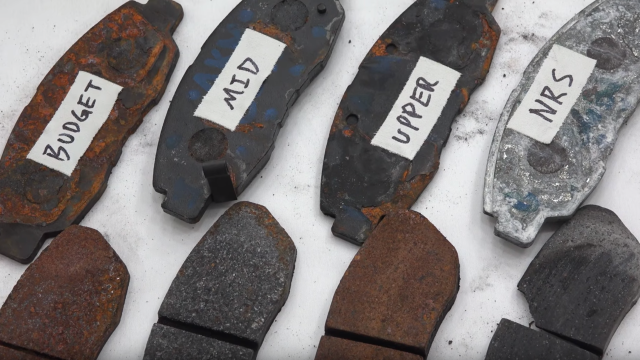The cost of car maintenance covers a pretty broad range. While it can be tempting to buy the cheapest products—brake pads, for example—to take a little strain off your wallet, there’s always the thought that maybe those more expensive pads might actually hold up better in the long run. But are they actually worth it? And, if they are, do you have to go really expensive to see any benefits to both your vehicle and your budget?
For our answer, we turn to Engineering Explained on YouTube, which purchased five different brake pads at various price points and put them all through similar tests to see which were more durable when faced with high temperatures, corrosion, and general compositional tests.
Each brake pad tested in this video came from different manufacturers, but were made for the front brakes of the same model vehicle. The brake pads chosen are the low-tier, mid-tier and upper-tier priced pads that you could find at your local parts store, the original pads found on the car from the manufacturer, and pads from NRS (the company sponsoring the video; it’s at the NRS test facility that the video is filmed).
Each set of pads underwent four tests: a performance test to look at brake fade, followed by a corrosion test, a shear test, and, finally, a noise test.
The video gets pretty science-y (it’s well-explained and easily digestible, but I’ll let you watch the video and hear it straight from Engineering Explained) but the results are pretty clear. The cheapest, budget-tier brake pads are often the most unpredictable. If you were to take these pads out to a track day, you’d notice a lot of variability in the pressure needed to slow the car down, especially right at first. The longer you run with the cheaper brake pads, the faster they’ll wear out—which isn’t ideal for the whole “saving money” thing, considering you’ll have to replace them more often.
But what if you live in the terrible, terrible North, where harsh winter conditions (and salt corrosion) wear at your brakes? Interestingly, all the tiered pads you can buy at the store were covered with rust after the corrosion test, while the OEM and NRS pads remained pretty clean. Rust, as you can imagine, is not great; the whole-arse pad can just slowly start falling off when subjected to a lot of use.
The main takeaway here is that of all the tiered options you can buy at the parts store, the mid-tier pads actually proved to be the most durable—even when compared to the most expensive, high-tier brake pads. Those mid-tier pads are worth the extra money you spend, but you don’t have to break the bank to get them. But, if you can, it’s still best to nab yourself some OEM pads if you can.
